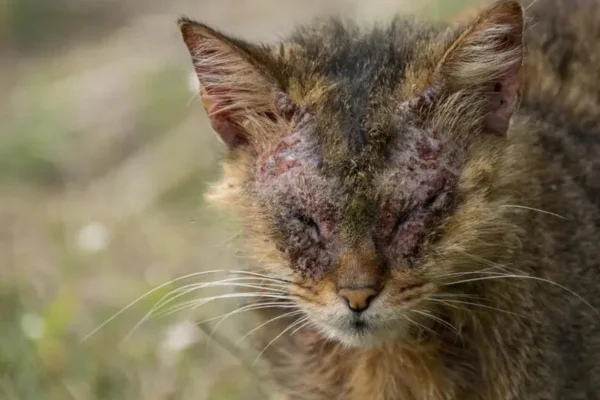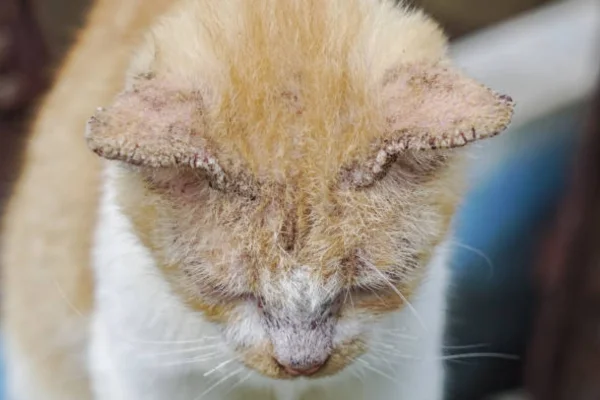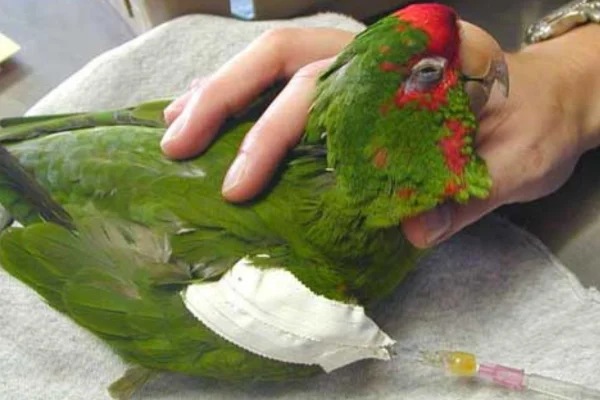Scabies in Cats:
Understanding Symptoms, Treatments and Prevention
Scabies in Cats: Scabies is one of the dermatological conditions most feared by cat owners. This affliction, caused by microscopic mites, is responsible for intense discomfort, itching and inflammation on the skin of felines.
However, despite being a worrying disease, with the right diagnosis and appropriate treatment, it can be controlled and eliminated.
In this article, we're going to take an in-depth look at the causes, the types of mange that affect cats, their symptoms, forms of treatment and, of course, how to prevent this disease to ensure the well-being of our feline companions.
Contents
What is Scabies in Cats?
Scabies is a skin disease caused by different types of mites that lodge in the epidermis of cats. These microscopic parasites feed on the skin, causing a series of reactions ranging from mild irritation to severe inflammation. Scabies doesn't just affect outdoor cats; even cats living indoors can contract the disease, either through contact with other infected animals or contaminated objects.

Types of Scabies in Cats
There are three main types of mange that can affect cats: otodectic mange (or ear mange), notoedric mange and demodectic mange. Each type is caused by a different mite and has specific symptoms.
1. Otodectic Scabies (Ear Scabies)
Otodectic mange is one of the most common forms of mange in cats, and is caused by the mite Otodectes cynotis. This type of scabies mainly affects the ears, causing intense itching and inflammation in the ear canal. One of the most obvious signs is the presence of a dark, waxy secretion, reminiscent of coffee grounds. If left untreated, ear scabies can develop into secondary bacterial infections and even hearing loss.
2. Notoedric scabies
Caused by the mite Notoedres catiNotoedric mange is highly contagious and mainly affects cats' heads and necks. It initially manifests itself with small scabs and redness on the skin, which over time can spread to other parts of the body. Notoedric mange is known for being extremely pruritic, i.e. it causes intense itching, which leads the cat to scratch vigorously, resulting in lesions and secondary infections.
3. Demodectic mange
Although rarer in cats than in dogs, demodectic mange, caused by the mite Demodex catiIt can affect cats with weakened immune systems. Unlike the other types, demodectic mange is not highly contagious. Symptoms include hair loss in localized areas and, in severe cases, inflammation of the skin and bacterial infections.
Symptoms of Scabies in Cats
The symptoms of scabies in cats can vary depending on the type of mite involved, but some signs are common to all forms of scabies. Among the most frequently observed symptoms are:
- Intense itching: Itching is the most characteristic symptom of mange. The cat may scratch or lick itself incessantly, trying to relieve the discomfort.
- Hair loss: Hair loss, known as alopecia, can occur in specific areas or spread all over the body, depending on the severity of the infestation.
- Redness and inflammation of the skin: The skin can become red, inflamed and hot to the touch, indicating the presence of an infection or irritation.
- Wounds and scabs: In response to the intense itching, the cat may create sores when scratching, which can develop into scabs and eventually secondary infections.
- Secretions in the ears: In the case of otodectic mange, it is common to see dark, waxy secretions in the ears, as well as an unpleasant smell.
Diagnosis of Scabies in Cats
Diagnosing scabies in cats can be challenging, as its symptoms are similar to other dermatological conditions, such as allergies or fungal infections. For this reason, it is essential to seek the advice of a veterinarian, who will be able to carry out specific tests, such as a skin scraping, to identify the type of mite present. In some cases, it may be necessary to carry out a skin biopsy or other laboratory tests to confirm the diagnosis and define the most appropriate treatment.
Treatment of Scabies in Cats
The treatment of scabies in cats depends on the type of scabies and the severity of the infestation. Fortunately, most cases of mange can be treated effectively with appropriate medication. Here are the most common treatment options:
1. topical and systemic drugs
To treat mange, the vet may prescribe topical medications, such as ointments or lotions that should be applied directly to the affected areas. In more serious cases, systemic medication, such as tablets or injections, may be necessary to eradicate the mites from the cat's body. It is important to strictly follow the vet's instructions regarding dosage and duration of treatment.
2. Medicinal baths
Medicinal baths with specific products to treat mange can be indicated to help relieve symptoms and eliminate skin mites. These baths should be done carefully, avoiding contact with the cat's eyes and mouth, and always under the guidance of a professional.
3. Treatment of secondary infections
In cases where scabies has already caused secondary skin infections, the vet may prescribe antibiotics or antifungals to treat these complications. Treating the infections is crucial to prevent the condition from worsening and to ensure a full recovery.
4. Isolation of the Infected Animal
As mange is highly contagious, especially notoedric and otodectic mange, it is recommended to isolate the infected cat from other animals during treatment. This will help prevent the spread of the disease to other pets in the house.
5. Sanitizing the environment
Cleaning and disinfecting the environment where your cat lives is essential to prevent re-infestation. All items used by the cat, such as beds, blankets, toys and even furniture where it usually lies, should be sanitized. In cases of severe infestations, it may be necessary to discard some items, such as fabric beds, to ensure that all the mites are eliminated.

Prevention of Scabies in Cats
Preventing mange is always the best approach. Some measures can be taken to reduce the risk of your cat contracting the disease:
- Maintain good hygiene: Regular bathing and brushing of the cat's coat helps to remove dirt and possible parasites that may be on the skin.
- Avoid contact with infected animals: If you know that an animal has mange, avoid letting your cat have direct contact with it.
- Regular cleaning of the environment: Keep the environment where your cat lives clean and sanitized at all times, especially areas where he usually lies down or sleeps.
- Regular visits to the vet: Regular visits to the vet are essential to detect any health problems early on, including mange.
Scabies in Humans: Can I Catch Scabies from My Cat?
A common question among pet owners is whether mange can be transmitted to humans. The answer depends on the type of mange. Notoedric mange can, in rare cases, affect humans, causing a rash similar to dermatitis. However, these mites are unable to complete their life cycle on human skin, so the symptoms disappear on their own after a while. Even so, it's important to wash your hands thoroughly after handling an infected cat and seek medical advice if you notice any skin irritation.
Conclusion
Scabies in cats is an uncomfortable but treatable disease. With early diagnosis and appropriate treatment, it is possible to eliminate the mites and restore health and comfort to your feline. As with any health issue, prevention is the key, and maintaining good hygiene, avoiding contact with infected animals and regular visits to the vet are the best ways to protect your cat from mange. Always remember to follow the vet's advice and not try to treat mange yourself, to ensure your pet's safety and well-being.








